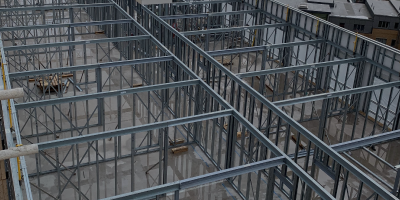22/02/2022
Improving predictability, sustainability, safety and quality with BIM
Offsite Construction is proclaimed to have a great number of benefits, from time and labour savings to improved predictability, sustainability, safety and quality. At the core is a need for accuracy, which is perhaps why Building Information Modelling (BIM) is often deemed the perfect partner for Offsite Construction.
Our Operations Director, Nick Milestone, recently sat down with the team at Tekla to share how his team have been utilising the power of 3D modelling within offsite.
Speaking on why BIM is such a great fit for offsite construction, Nick commented: It has to be the accuracy. The clash detection capabilities, enhanced level of detail and greater visualisation that the 3D digital environment offers, all provides the assurance that if it fits in the model then you know it will fit on site. While this assurance is of course valuable on any construction project, it’s perhaps especially critical when it comes to offsite; given that one of its primary advantages is for on-site assembly to be both quick and efficient. If components don’t fit together correctly, then that level of efficiency will fall dramatically.
Essentially, it’s the idea of a digital rehearsal. You get to construct it twice: once in the digital environment and once on site. From accuracy at the detailing phase through to on-site coordination, Tekla software comes into play at every stage and feeds into our VDC (Virtual Design and Construction) processes.
Taking this theme of accuracy further, Sigmat has recently worked closely with Trimble to embed Sig-Deck (Sigmat’s own decking profile product) into the Tekla BIM library in Tekla Structural Designer. Having access to this product-specific content will in turn lead to enhanced levels of accuracy, as well as aiding engineers from a design calculation point of view.
Nick continued: Another benefit of BIM for offsite has to be the data integration that it enables. All the constructible data is present and coordinated throughout the entire process, ensuring that the high levels of accuracy are maintained from the detailing stage through to factory fabrication and beyond.
When it comes to fabrication, we’re able to upload the CNC files from the Tekla Structures model directly into the factory and use this data to programme our machinery. When processing stud and track profiles, for example, the machines will use the model data to correctly profile it, cut it to specification, drill the holes, etc. Fully automated, this enables our steel frame fabrications to be carried out to extremely high levels of accuracy – to within 2mm.
As well as offering a connected data journey, the Tekla modelling software is also designed to work with a variety of construction materials, including steel, concrete and timber.
Nick explained: At Sigmat, we work with both hot-rolled and cold-formed steel. As such, it’s important that our chosen modelling software is able to keep up and allows us to detail and consider all materials within the one model environment. As well as saving time and improving productivity levels when it comes to the detailing process – avoiding the need to swap between multiple software interfaces or deal with a number of file types – this is another factor that contributes to high levels of accuracy.
In turn, this overarching theme of accuracy also feeds into another major subject facing the construction industry: sustainability. Indeed, by combining offsite and BIM, the result is a largely sustainable and more efficient process.

Sustainability is a key consideration for us all at Sigmat. Thanks to our BIM workflows and the accuracy that this 3D modelling enables, it means that we can achieve zero waste. With correct material quantities ordered, thanks to the automatic quantity take-offs; no rework required due to detailing or fabrication errors and integrated data.
In addition to the Tekla structural modelling software, Sigmat has recently incorporated Trimble Connect - Trimble’s cloud-based collaboration platform - into its business. Used throughout the company, both internally and externally, Trimble Connect is facilitating effective communication and coordination.
Nick explained: As well as using the Trimble Connect platform to share files and models internally within Sigmat project teams, we’re also able to better communicate with the client and other key project stakeholders. Everyone is a part of the same project. While collaboration is important on any construction project, it’s perhaps especially critical when it comes to offsite, volumetric and modular. For example, our pre-panelised frames will often require close coordination with M&E contractors, ensuring that we are all aware of what the other party is doing.
Sigmat is also utilising the benefits of Trimble Connect on site, with its site teams using Trimble Connect to access the model and drawings via their tablet, cross-comparing the model with the site assembly and viewing construction details.

Read the original case study: TEKLA UK




